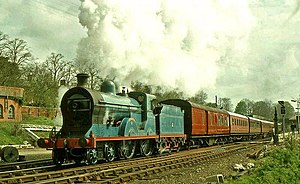GNRI Class S
| GNR(I) classes S and S2 | |||||||||||||||||
|---|---|---|---|---|---|---|---|---|---|---|---|---|---|---|---|---|---|

|
|||||||||||||||||
|
|||||||||||||||||
|
|||||||||||||||||
|
|||||||||||||||||
| Type and origin | |
|---|---|
| Power type | Steam |
| Builder | Beyer, Peacock |
| Build date | S:1913 S2: 1915 |
| Total produced | S: 5 S2: 3 |
| Specifications | |
|---|---|
| Configuration: |
|
| • Whyte | 4-4-0 |
| • UIC | 2′B h2 |
| Gauge | 5 ft 3 in (1,600 mm) |
| Driver dia. | 6 ft 7 in (2,007 mm) |
| Cylinders | Two, inside |
| Cylinder size | 19 in × 26 in (483 mm × 660 mm) |
| Career | |
|---|---|
| Operators | GNR(I) » CIÉ / UTA |
| Numbers | S: 170–174 S2: 190–192 |
| Preserved | No. 171 |
| Disposition | One preserved, remainder scrapped |
The Great Northern Railway (Ireland) class S was a class of five 4-4-0 steam locomotive that the Great Northern Railway introduced in 1913 to haul Belfast – Dublin express passenger trains. They were followed two years later by the three similar class S2 locomotives.
All were built by Beyer, Peacock and Company at their Gorton Foundry, Manchester.
The locomotives were delivered during a time when the GNRI was removing names from locomotives. The S class locomotives carried names from new, but gradually lost them, so by 1925, only 170 Errigal retained its name. This it lost in 1930. The S2 locomotives were allocated the names Lugnaquilla, , and , but they were never carried. With the introduction the class V locomotives in 1932, the GNRI revived the practice of naming locomotives; the S2 class acquired new names, and the S class regained their old ones as they went though the works for rebuilding in the late 1930s. All were named after mountains in Ireland.
Much of the GNR network was closed in 1957 and the remaining system was split between Córas Iompair Éireann (CIÉ) and the Ulster Transport Authority (UTA) in 1958, with the fleet divided as equally as possible between the two parties. The UTA renumbered their locomotives, whereas the CIÉ merely added an "N" suffix to the locomotives' former GNRI numbers.
CIÉ soon replaced its remaining steam locomotives with diesels and sold four of its former GNRI steam locomotives – all three S class and one VS class – to the UTA in 1963.
The UTA based some of its S class locomotives in Belfast and used it to haul trains on the Belfast – Portadown main line and Portadown – Derry "Derry Road".
One member of the class, No. 171 Slieve Gullion, is preserved. In preservation it has covered most of the Irish railway system, including many non-GNR(I) lines.
The locomotive was in service until 2002 when its boiler certificate expired. Growing Rural Opportunities Within (GROW) South Antrim is now funding the locomotive's restoration. In January 2014 the locomotive was transported to Railway Restoration North East Ltd in Shildon, County Durham, which is undertaking the work.
...
Wikipedia
